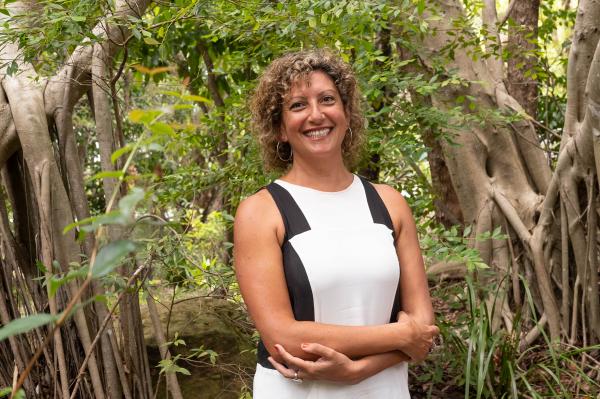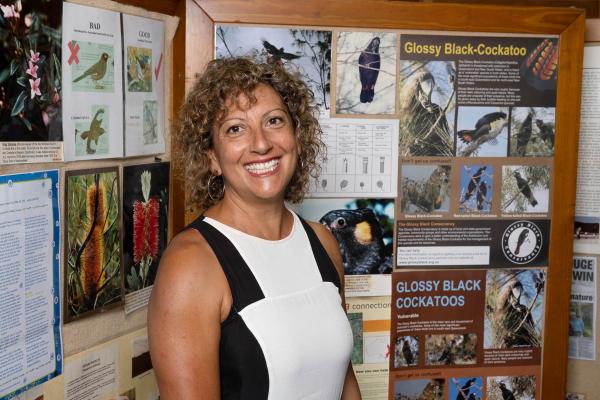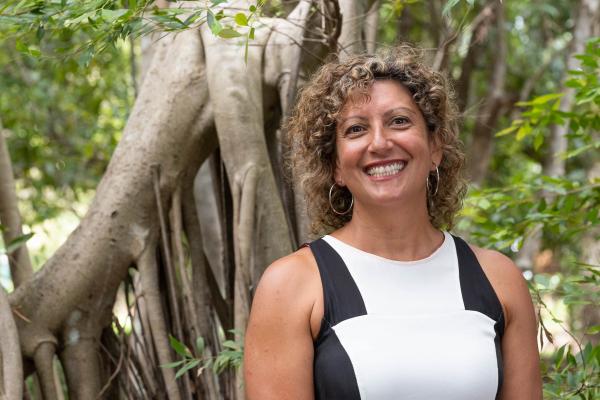Dalia Mikhael wears so many hats she could open a millinery shop, but she’d be too busy to run it.She is currently director of the Grass Roots Marketing Alliance, managing director of Noosa Environmental Education Hub and project officer for Zero Emissions Noosa, and that’s just the big ticket items. Dalia has spent many years designing and delivering “outdoors immersion” environmental programs that give life to the curriculum, while promoting Indigenous led, biodiversity discussion. Oh, and she’s also the mother of a seven-year-old daughter with musician husband Peter Wood, a former leading New Zealand multi-instrumentalist (Salmonella Dub).
Of Egyptian parentage, Dalia was the first of her family to be born in Australia, and grew up in Brisbane, attending Corinda High before doing a marketing degree at QUT, where she realized she was no great fan of any kind of mass marketing. So she dabbled in market research before finding a niche in the electricity industry, which was just starting to educate its customers about renewables. This was an application of marketing she could embrace, and ultimately it led to her founding of the Grass Roots Marketing Alliance, specializing in community engagement.
Dalia, Peter and their newborn moved to an acreage in the wallum at Weyba Downs in 2013, and Dalia quickly got involved in the challenging but rewarding business of educating people about the linked issues of the environment, sustainability and First Nations culture.
PHIL JARRATT sat her in the Noosa Today Hotseat.
So the marketing degree basically turned you off marketing?
It did, absolutely. It made me realise that there was so much to be done in grass roots communications, getting people to do the right thing for the planet. I think I was naïve enough to believe that this was what marketing was actually about, but as soon as I got thrust into the fast food and beverages kind of marketing, I quickly changed my mind. So I set up the Grass Roots Marketing Alliance in about 2000.
But this was after you graduated and started working in mass marketing, right?
Yes, I worked in market research for a while, and then went into the electricity industry and worked in every facet of that. This was my introduction to the school curriculum because I developed a program called Solar Schools, in which the data from the use of solar panels was presented to students so that they could learn about energy efficiency. It was just a part of the industry’s move into renewables, and no one really understood much about it.
What was the catalyst that got you into communicating information about renewables?
I understood that education was necessary across the board in all industries, and in the electricity industry particularly, they needed to know about climate change and emissions. It kind of went from that to the logical next step, which was to educate young people before they entered the workforce.
This is about 20 years ago. Were you ahead of the curve?
Yes, in some ways. My whole approach was that marketing had to be of mutual benefit, a win-win for all. In the electricity industry that meant that the industry got a higher profile for the new renewables projects they were working on and the students got the benefit of this important educational resource.
In the marketing of measures to save the planet, does everything have to be a win-win? By now couldn’t you just sell solar on the good it’s doing rather than the cost savings?
I think that even today there is some fear about making that the rationale, and Covid set it back too. In today’s world it has to be seen as an economic benefit first and an environmental benefit second. Fortunately, with solar it is absolutely both.
Does Grass Roots Marketing Alliance still exist?
Yes, it does, and I still apply those philosophies developed at Grass Roots to virtually everything I’m doing, including the Noosa Environmental Education Hub, where the focus is not on us, it’s on the students. And it’s the same with the work I’m doing at the moment with the Noosa World Surfing Reserve to bring their surf safety awareness and Surf Code programs into schools.
You have a marketing degree but you’re not an educator and yet you seem to excel at getting the message into the school curriculum. How?
Well, my relationship with the education system really began with Solar Schools which was a great way to start because we were giving them a freebie – the industry was giving this to the Department of Education. That put me in a position of being able to connect with the curriculum leaders, and those contacts have grown over the years. Through that work I really got to understand what the Australian Curriculum was about and what its desired outcomes were, and how I could contribute to it.
Tell me how the Noosa Environmental Education Hub came into being.
In 2013 when we moved to Weyba Downs, everything looked so green and lovely, but then came the realization that there was a lot of biodiversity loss in Noosa, endangered species, like our koala, and other issues. On the other hand, there were environmental groups that had been going since the year dot and were the reason the place looks the way it does. But there was this gap – an aging population of participants and no one filling it from the younger generation. I kept hearing they weren’t interested, you couldn’t get them to do anything.It took a while, but I realized that here was something I could help fix. My two co-directors at the Hub now, Di Seels and Annika Patrick, were working at an outdoor space at Sunshine Beach primary school when I happened to waltz in one day to donate a beehive, and I looked around and thought every school should have something like this. I got to talking with Di and Annika and together we created the Hub in 2019. The Biosphere Reserve liked what was happening and asked if we could recreate it at other schools. We said rather than do that why don’t we approach it holistically and provide the programs which we could take anywhere.
They gave us some seed funding and we came up with our first programs, one of which was Waterways Health, in which a school adopts a waterway, and the kids do water analysis using NICA’s monitoring system.The list of programs now coming out of the EE Hub is long and I’m sure we’ll get to most of them, but can you start by explaining Aboriginal Perspectives?
Aboriginal Perspectives is not ours but it’s a cross-curricular priority and not done very well, so we’re trying to build a better framework for it. For me, if you want to talk about an area’s biodiversity, no one can explain it better than the original inhabitants. A lot of the information is fragmented, but there is such beauty in bringing experts from the Kabi Kabi into the schools to explain the land.
Bioregionalism?
Bioregionalism is an interesting one. It’s about teaching students about the ecosystems that support their existence in a certain place, teaching them about the place they live in a completely different way. We’re just finalizing a sponsorship on that which will enable us to roll it out in the near future.
Why does the education department need a body from outside, like the Noosa EE Hub, to develop environmental education programs?
A long time ago the Queensland Department of Education disbanded their curriculum development resource group, so while the Australian Curriculum decrees the type of things that Australian schools should teach, there really aren’t people here in the department who are generating curriculum. It all comes down to cost efficiencies, and in a way that’s been a blessing because it’s allowed industry to step up and build a partnership with the schools.
Doesn’t that open the door to branding education?
Well, I was always fearful that a McDonalds would want in, but schools are pretty savvy in understanding what is appropriate. Most schools today want to have a community relationship and for it to have relevance in their curriculum, but they’re not always sure how to go about it. When we bring to them something that’s Noosa Biosphere specific, it gives kids the chance to get their hands dirty while learning elements of the essential curriculum. And the teachers are happy to see the kids get more engaged in learning that isn’t text book-driven.
At the Hub we’re really focused on working with Noosa Biosphere and Noosa Council to get their environmental and sustainability messaging to the whole community, so as our schools programs become entrenched in the curriculum, the potential to do that is massive and cost-effective. But most marketers still want to use traditional mediums, like TV commercials. When I developed Solar Schools for the electricity industry, a New Zealand company called Genesis Energy jumped on it, and found they now had something to talk about in their TV commercials, how they were putting solar panels into schools.
How did you move from convincing corporations that they needed you to convincing community groups and organisations?
When I first moved to Noosa I did a lot of volunteering with community groups and got to understand how they operated, the fundamentals and the nuances of what they were doing. And that’s been really helpful in explaining to them what we can offer at the Hub, like bringing the schools on board and making their programs curriculum-linked.
If a school accepts your program for inclusion in its curriculum, what happens then? Do you go in and educate the educators?
Pretty much, yes, but there’s definitely a redundancy clause. When the teachers are confident to deliver the program without us, we’re out. But the community group partnerships that have been formed remain.How does the funding for these programs work? Can the schools afford to pay you for developing them?
The schools get funded each year for their educational resourcing, and they get STEM funding (science, technology, engineering and maths) which decreases each year but hopefully not to zero. The idea is that it’s to be used for sustainability education, so that enables us to be funded directly by the schools where our programs are directly relevant to their curriculum. We also rely on other funding. For example, Noosa Youth Advocacy Group is not something we can charge the schools for, it needed to be funded externally and Noosa Council stepped in, but it’s another win-win because they need to develop support and get input across generations for their key strategies.
Is the Youth Advocacy Group designed to churn out little Greta Thunbergs?
Not so much. (Laughs) It’s designed to give them a voice, and they come up with some great ideas that often come from what’s affecting them personally. They are often concerned about the number of jobs for young people in Noosa, and the Advocacy Group allows them to step up and do something about creating sustainable employment. But yes, some do want to become little Gretas, and through the program we teach them how to control eco-anxiety and work for positive change instead of inheriting this massive problem that our generation has created for them.
For me school education is public education, because once you get kids to adopt a new way of thinking, they take it home and educate their parents.









